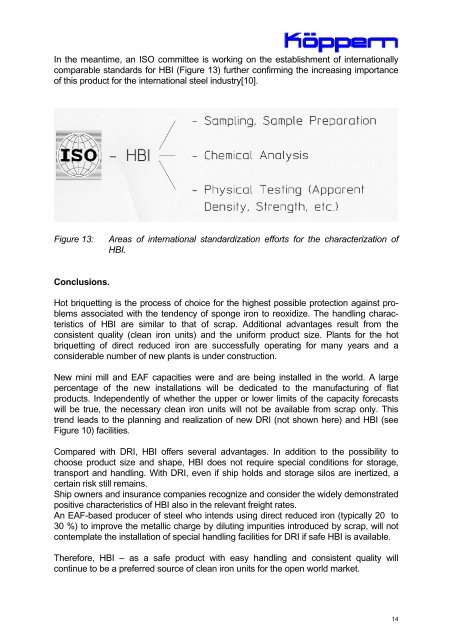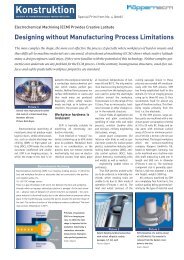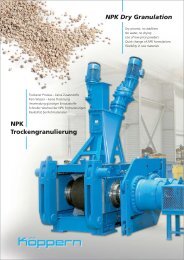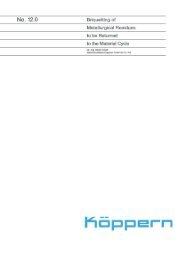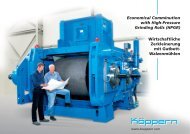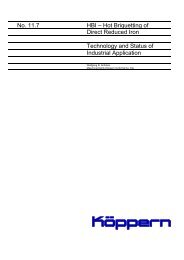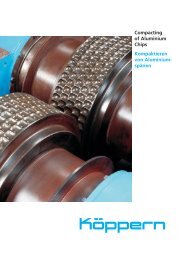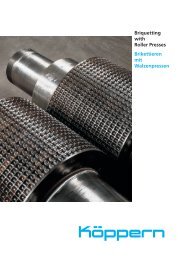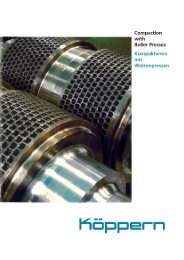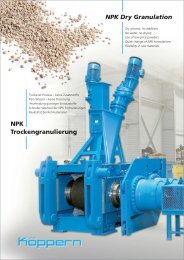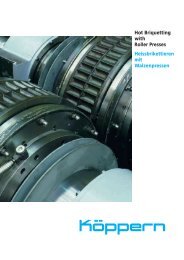Hot Briquetting of - Maschinenfabrik Köppern GmbH & Co. KG
Hot Briquetting of - Maschinenfabrik Köppern GmbH & Co. KG
Hot Briquetting of - Maschinenfabrik Köppern GmbH & Co. KG
Create successful ePaper yourself
Turn your PDF publications into a flip-book with our unique Google optimized e-Paper software.
In the meantime, an ISO committee is working on the establishment <strong>of</strong> internationally<br />
comparable standards for HBI (Figure 13) further confirming the increasing importance<br />
<strong>of</strong> this product for the international steel industry[10].<br />
Figure 13: Areas <strong>of</strong> international standardization efforts for the characterization <strong>of</strong><br />
HBI.<br />
<strong>Co</strong>nclusions.<br />
<strong>Hot</strong> briquetting is the process <strong>of</strong> choice for the highest possible protection against problems<br />
associated with the tendency <strong>of</strong> sponge iron to reoxidize. The handling characteristics<br />
<strong>of</strong> HBI are similar to that <strong>of</strong> scrap. Additional advantages result from the<br />
consistent quality (clean iron units) and the uniform product size. Plants for the hot<br />
briquetting <strong>of</strong> direct reduced iron are successfully operating for many years and a<br />
considerable number <strong>of</strong> new plants is under construction.<br />
New mini mill and EAF capacities were and are being installed in the world. A large<br />
percentage <strong>of</strong> the new installations will be dedicated to the manufacturing <strong>of</strong> flat<br />
products. Independently <strong>of</strong> whether the upper or lower limits <strong>of</strong> the capacity forecasts<br />
will be true, the necessary clean iron units will not be available from scrap only. This<br />
trend leads to the planning and realization <strong>of</strong> new DRI (not shown here) and HBI (see<br />
Figure 10) facilities.<br />
<strong>Co</strong>mpared with DRI, HBI <strong>of</strong>fers several advantages. In addition to the possibility to<br />
choose product size and shape, HBI does not require special conditions for storage,<br />
transport and handling. With DRI, even if ship holds and storage silos are inertized, a<br />
certain risk still remains.<br />
Ship owners and insurance companies recognize and consider the widely demonstrated<br />
positive characteristics <strong>of</strong> HBI also in the relevant freight rates.<br />
An EAF-based producer <strong>of</strong> steel who intends using direct reduced iron (typically 20 to<br />
30 %) to improve the metallic charge by diluting impurities introduced by scrap, will not<br />
contemplate the installation <strong>of</strong> special handling facilities for DRI if safe HBI is available.<br />
Therefore, HBI – as a safe product with easy handling and consistent quality will<br />
continue to be a preferred source <strong>of</strong> clean iron units for the open world market.<br />
14


